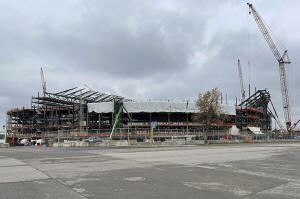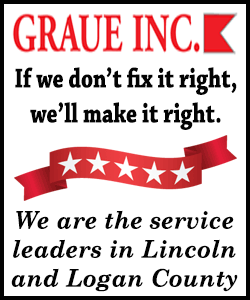Bills' new stadium costs balloon to
$2.1 billion, $560 million over initial estimate, team tells AP
 Send a link to a friend
Send a link to a friend
 [November 16, 2024]
By JOHN WAWROW [November 16, 2024]
By JOHN WAWROW
ORCHARD PARK, N.Y. (AP) — The projected cost of the Buffalo Bills'
new stadium has ballooned to what team officials on Friday told The
Associated Press is “north of $2.1 billion,” with owners Terry and
Kim Pegula responsible for picking up the more than $560 million in
overruns.
Bills president Pete Guelli said he was not surprised by the amount,
given how the numbers have been tracking up since construction began
16 months ago. And he said the projected total represents the
commitment the Pegulas have to the community because they are
sticking to their vision for the facility without cutting corners to
reduce costs.
“To sum that up, the Pegulas will not deviate from building a
best-in-class stadium in Buffalo,” Guelli said.
“It’s going to be an exceptional fan experience, and incredible
place to play. I think we’re very proud that we can build a facility
like this in Buffalo and have it available to our fans,” he added.
“We need this project to be a success for the team on and off the
field, and it will be.”
Guelli said the increased costs will not impact the timetable for
completion. The stadium is being built across the street from the
Bills’ current home and is on track to open by June 2026.
Taxpayers are committing a combined $850 million to the project —
$600 million from the state and $250 million from the county. At the
time of the deal reached two years ago, that represented more than
half the cost of construction, but now, taxpayers will be
responsible for about 40%. The Bills are responsible for any
overruns beyond $1.54 billion.
“I’m very pleased knowing that when all is said and done — and it
still isn’t done, so it could go up even more — that the county is
going to probably have contributed no more than 12% of the total
cost, which is a pretty good deal,” Erie County executive Mark
Poloncarz told The AP.
The Pegulas are now on the hook for $1.25 billion in construction
costs, plus $144 million more as part of a community benefits
package to be spread out over the 30-year lease.
The Bills are funding their share through an NFL loan program as
well as raising money through a first-time seat licensing fee for
season-ticket holders. Preliminary plans are also in the works to
establish an entertainment zone, featuring restaurants, bars and
shops, to be built once the existing stadium is razed.
Pegula is also raising money by seeking to sell off a minority share
— no more than 25% — of the franchise, though Guelli said the
reasons behind the move are not connected to increased construction
costs. The Bills met with several interested groups over the summer
and into September, with Pegula expected to identify a new partner
by the end of the year.
The Pegulas bought the Bills for $1.4 billion from the estate of
late Hall of Fame owner Ralph Wilson in 2014. Forbes most recently
valued the Bills at $4.2 billion.
[to top of second column] |

Construction continues on the Buffalo Bills' new stadium, Friday,
Nov. 15, 2024, in Orchard Park, N.Y., which is on track to open in
time for the 2026 NFL football season. (AP Photo/John Wawrow)

The new building will seat about 60,000, down from
about 72,000 from the team’s existing stadium that opened in 1973
and is considered technologically outdated and experiencing cracks
in its structure. Though the new stadium doesn’t include a roof, it
will feature curved sides to cover a majority of seats.
And unlike the current facility, which faces east-west, the new
building is positioned facing north-south to better protect fans
from the winds that blow in off nearby Lake Erie.
John Polka, vice president of stadium development, said inflation
played a significant role in the price jump by pushing up material
construction costs. Two more contributing factors, he said, were
increasing labor costs and design features that were added after the
Bills completed their agreement with the state and county.

“We could have stopped at some point and said, let’s cut back. And
that was not the case at all. In some cases, we’ve actually gone
back in recent months and said, ‘Hey, we’ve got an idea or something
that we think will enhance the fan experience or give us a better
competitive advantage,’” Polka said. “And that’s really a testament
to the Pegulas saying: ‘This is what we want to build. We designed
it. This was our intent. There were reasons behind it, and we’re
going to move forward with that.’”
New York’s Empire State Development, which will oversee the
operation of the new stadium, noted that aside from having the
state’s share reduced to about 29%, the negotiated deal also
resulted in $462 million in contracts awarded to minority and
women-owned businesses.
Guelli, who took over as president of the Bills and the Pegula-owned
NHL Sabres in March, noted the significance of what the new stadium
represents by recalling Bills fans’ fears of the franchise
relocating when he previously worked for the team in the 2000s.
“People were talking about the Bills potentially leaving and now
there’s a $2 billion stadium going up across the street to keep the
team in Buffalo long term,” Guelli said. “It’s pretty gratifying for
everybody to be a part of it, especially with the Pegula family.”
All contents © copyright 2024 Associated Press. All rights reserved |